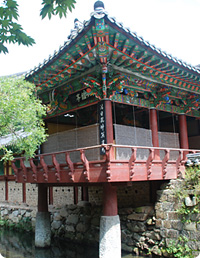PACKAGE
Seoraksan 6 days
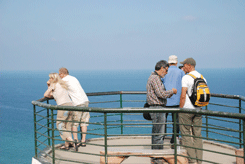
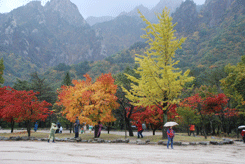
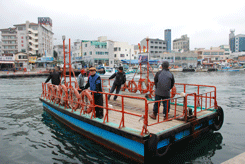
Tour Highlights
- Gyeongbokgung Palace
- National Folk Museum of Korea
- Jogyesa Temple
- Insadong
- Namdaemun Market
- Unification Observatory
- Kim Ilsung Villa
- Geojin Fishing Village
- Seoraksan National Park
- Woljeongsa Temple
- Yeongneung Tomb
- Hwaseong Fortress
Click on the days to access the program quick
| Days | Visits and Activities | Distance |
| Day 1 | Arrive Seoul | 60km |
| Day 2 | Seoul | |
| Day 3 | Seoul - Goseong - Hwajinpo - Geojin - Seoraksan | 310km |
| Day 4 | Seoraksan | |
| Day 5 | Seoraksan - Odaesan - Yeoju - Suwon - Seoul | 300km |
| Day 6 | Departure | 60km |
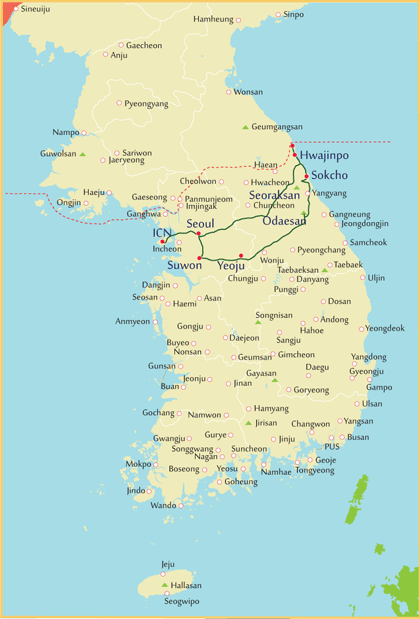 Day 1 Arrive Seoul (- - -)
Day 1 Arrive Seoul (- - -)
60km
Touching down at Incheon International Airport places you in the heart of Korea. After you clear Passport and Customs control, you will be welcomed by the tour guide and then transferred to your hotel.
Day 2 Seoul (B)
Your exploration this morning begins with a driving tour of Seoul, featuring sites such as Seoul Plaza, City Hall, Cheonggye Square and pedestrian-friendly Gwanghwamun Plaza that is hemmed in on three sides by rushing traffic. The plaza is lined on each side with 365m long streamlets, two centimeters deep and one meter across, the stone bed of the plaza's east side waterway engraved with important events in chronological order from 1392 to 2008.
Standing high on a stone pillar is a statue of Yi Sunsin who had engaged in twenty-three naval battles and emerged victorious in all of them during the Hideyoshi invasion (1592-1598). King Sejong who propagated the Korean alphabet in the 15th century is also honored with prominent statue. On August 16, 2014, Pope Francis celebrated Mass in this plaza to beatify 124 Korean martyrs. Near the southwest corner of the plaza is Korea's Kilometer Zero, marking the distances to 64 cities around the world, including Seoul's antipode, Montevideo, Uruguay, 19,606km.
Step back in time to when life was gracefully slow and discover Gyeongbokgung Palace, a particularly charming spot that represents a colorful and turbulent side of the capital's 500-year history. Depending on timing, you may witness the Royal Guard Changing Ceremony featuring parade, password verification, duty shift and patrolling the gate. Accompanied by a court band with its colorful costumes and royal flags, the ceremony is performed daily basis at 10:00 and 14:00 except Tuesdays, although it is cancelled in case of rain or extremely hot or cold weather.
Up from the gates is a spacious stone-paved courtyard that is fully enclosed by wooden cloisters, and at the center of which runs three footpaths through two rows of rank stones, indicating the positions of the officials with the highest rank being closer to the hall.
Standing majestically on top of a two-tiered stone platform that is lined with detailed balustrades is Geunjeongjeon Hall, where the king formally granted audiences to his officials, gave declarations of national importance, presided over large official functions, and greeted foreign envoys and ambassadors. Check out the royal throne and a large painting, depicting sun, moon, five peaks, streams and pine trees, which was the crucial signifier of the king. And up in the center of the ceiling, the bright golden dragons in bold relief indicate the presence of the king.
At the back of the throne hall is a group of court offices. Displayed in front of the King's official quarters is sundial, conceived in order to catch the shadow of the sun, which tells time and 24 periods of seasonal change from the winter solstice to the summer solstice.
Sitting on the island in the rectangular lake is Gyeonghoeru. Supported by 48 square and cylindrical massive stone pillars representing the idea of Yin and Yang, this magnificent pavilion was used for many purposes ranging from receptions to national examinations.
Gangnyeongjeon is the king's sleeping and living quarters while Gyotaejeon is the queen's domain containing a number of halls. The noted feature of these main buildings is an absence of a top roof ridge.
Amisan Garden, landscaped with four hexagonal chimneys in orange bricks, is seldom noticed by the hurried visitors. Jagyeongjeon is the queen dowager's residence. Although less colorful, it is worth noting the wall, adorned with floral designs and the chimneys with ten longevity symbols.
Hyangwonjeong features a small pond with a manmade islet that supports a beautiful two-story pavilion. Behind this serene garden is Geoncheonggung, where the king and queen could relax in peace and quiet. It was here that the first electric lights in the country were installed in 1887 after 8 years of Thomas Edison's invention and a tragic chapter in Korea's history was recorded when empress Myeongseong was assassinated by the sword-bearing Japanese assassins in the early morning of 8 October 1895, allegedly under orders from Miura Goro.
Your visit to the National Folk Museum of Korea will familiarize you with wealthy culture of this friendly and picturesque nation. It is an excellent facility to illustrate the history of traditional life of the Korean people from the prehistoric age to the Joseon dynasty. The permanent exhibition features life and work, costumes and ornaments, handicrafts and technology, educations, living quarters, dietary life, oriental medicine, performing arts and games, beliefs and rituals, and
socio cultural life.
Squeeze in a stop at Jogyesa, is the head temple of Jogyejong the principal sect of Korean Buddhism, emphasizing the Zen orthodox, meditation tradition and the purity of monastic celibacy. The temple does not give off the solemn and traditional air of the other temples located deep in the mountains, but when you enter the temple the frenzy of the city start disappearing. The Main Worship Hall holds triad Buddhas, Sakyamuni, Amitabha and Bhaisajyaraja. The figure in the center is Sakyamuni Buddha who has overcome greed, hatred and delusion. While here it is worth noting the 500 year old lacebark pine and 400 year old locust tree that still grace the property.
Insadong, at one time the center of traditional Korean art and antiques, features a mixture of historical and modern atmosphere representing the cultural glimpse of the nation. Clustered along the main street and alleys are lined with street vendors, wooden tea houses, restaurants and numerous galleries and shops dealing in antiques, oriental art supplies, and modern Korean art of all types and styles. Soak in the paintings, upscale artworks, antiques and potteries while you can. Get lucky and you just might meet the artist themselves. It can be plenty of fun walking on the main street, but you venture into the hidden alleys that do spring some unexpected surprises. While here, you may want to buy some souvenirs or simply wander and browse at leisure admiring cultural ambience.
Drive past Cheonggyecheon Stream. After the Korean War (1950-1953), more people migrated into Seoul to make their living and settled down along the stream in shabby makeshift houses. The accompanying trash and waste, and deteriorating conditions resulted in an eyesore for the city. The stream was covered with layers of concrete in the mid 1950s and roadway until the massive urban renewal project freed it in 2005. Today, a 5.8km creek tumbles gently through downtown Seoul, providing a much needed source of peace and relaxation for the citizens of this fast-paced city. You may have a chance to view the sculpture standing tall at the head of the stream on a small plaza. Created by Dutch artist Coosje Van Bruggen and Swedish artist Claes Oldenburg, a shell rising upward like pagoda symbolizes new life.
You will tour the centuries-old Namdaemun Market brimming with well over 11,000 shops selling anything you can imagine. One of the most colorful aspects of the market is an endless sprawl of street-vendor stalls that setup in the alleys and walkways between the buildings. The market is seriously crowded, so be prepared to get bumped around. A fantastic place to haggle over the price to get the best deal on something you want or simply admire the vibrancy of this massive market.
At the western entrance of the market in the middle of a traffic circle stands Sungnyemun. It is a formidable and iconic construct that served as the southern gate of the wall that surrounded Seoul during the period of the Joseon Dynasty.
Day 3 Seoul - Goseong - Seoraksan (B) 290km
Your tour guide greets you in your hotel lobby and takes you on an excursion to Seoraksan national park. As you make your way to the east coast, enjoy the picturesque countryside, tranquil nature and beautiful landscape. At the northern tip of the east coast sits Unification Observatory. With the entry permit and sign to place in the vehicle window ready, continue towards the north, driving past lots of tank traps comprising large lumps of concrete set on either side of the road, all a strange and eerie reminder of the tensions that exist between the two Koreas and the stark reality of the divided country. While there, you will get a glimpse of the much talked about border dividing the two Koreas and see the road and train track stretched side by side ahead across the North Korea.
Stop at DMZ museum (closed on Mondays) offering very surreal experience of a lifetime. In the hopes of bringing peace to the country from the painful past, the museum presents the South Korean side of the conflict with the North, underscoring the historical significance of the DMZ and embracing everything about the latest efforts made to transform the DMZ from a place of political scars to a symbol of peace and ecology.
Enjoy a short tour of Socho that has so much more to offer than just mountains. In downtown, there is a colorful market selling fishes, fruits, vegetables, grains and daily necessities, and a little further down is a North Korean refugee village that can be accessible by a hand-pulled boat. At Daepohang, you will see a wide variety of fresh seafood harvested from the nearby sea and a number of small restaurants serving sliced raw fish. You will find something to enjoy, from simply feeling the ambiance of this small fishing port to taking picture.
Seoraksan national park is a place that you can definitely find lots of outdoor activities to make it worthwhile for an extended stay. The dense forests bordering crystal clear streams which tumble over cataracts and drop from precipices to form white waterfalls, as well as awesome saw tooth cliffs spiraling into the blue skies, and scenic valleys altogether make this park and surrounding area some of the most beautiful sceneries on the Korean peninsula, and give this area an unparalleled popularity around the year.
Day 4 Seoraksan (B
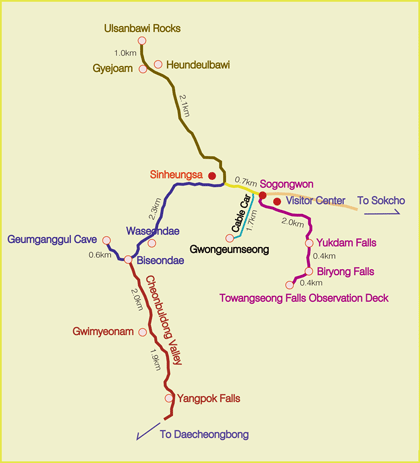 The word of the day is hiking of varying lengths and difficulty. All route types are out and back. Today, you will form your own independent tour to explore Seoraksan national park that has many different trails, and you are free to pick and choose which ones you want to do.
The word of the day is hiking of varying lengths and difficulty. All route types are out and back. Today, you will form your own independent tour to explore Seoraksan national park that has many different trails, and you are free to pick and choose which ones you want to do.
Only a small walk from the park entrance (Sogongwon),
you will marvel at a large bronze Buddha statue, symbolizing the reunification of Korea. A 14.6-meter, 108-ton gilt-bronze Buddha, sits atop a 4.3-meter high pedestal, of the same material, making the total height 18.9-meter, excluding the lightning rod and nimbus.
A little further on is Sinheungsa temple which claims to be the Korea's oldest Zen temple. Left trail in the direction of the temple is a trailhead of Cheonbuldong valley, the most impressive valley in the park, leading finally to the Daecheongbong peak of Seoraksan (1,708m), while right trail is up to Ulsan Bawi Rocks.
Among the most recommendable trails from Sogongwon are as follow and the given times below are based on round trip in a bit relaxed pace.


Cheonbuldong valley Trail
One hears many legends of the heavenly nymphs who come down to play at Biseondae while taking a bathe in the placid pools of the valleys that are hidden from the human eyes. Near Biseondae rises Janggunbong majestically and among the crags of it is a temple alcove, Geumgang cave. You may want to head up a very steep incline for 600m from the gentle slope of the trail, and you can scale only by carefully ascending the long, steep, metal stairs bolted onto the sheer cliff face. The hike, although hard, comes with a stunning view of numerous cliffy peaks and mountain valley. From Biseondae, another 3.5km to Yangpok Falls, so spacious yet everywhere you looked you are surrounded by giant mountain peaks.

Ulsanbawi Rocks Trail
About an hour and half into the walk from the park entrance is Gyejoam hermitage. Located at the base of Ulsanbawi, and the point at which the trail takes a sharp rise upwards. In front of the hermitage on a spacious stone slab is a huge spherical rock called Heundeulbawi. This rock is soperfectly balanced that it can be shaken with some effort, but nobody gets further than waggling it. Your adventure begins by climbing a massive steep staircase that winds its way up the side of the cliff that angle up Ulsanbawi which is in a folding screen shape made up of cliffs on all sides. It is a 1.8km-long ridge of naked, gray stone peaks jutting well over 800m into the sky.

Biryong waterfall Trail
The trail is relatively easy for anyone to try and you will view Biryeong waterfalls at the trail end. About 400m further above the falls, you will be amazed at Towangseong waterfalls cascading down a 320-meter cliff.
Cable Car
There is a cable car that picks you up at the valley floor to the Gwongeumseong. The peak is surrounded by cavernous drop-off cliffs, cloaked in more towering rocky summits. Definitely, you stand in awe on the top: sweeping panoramic views of the park around you, the Pacific Ocean, and the small beachside town of Sokcho. Be careful as always as there is not much room to move about and people constantly going up and down and moving around.
Hiking Trails
1. Biryong Falls (4.8km): 2 hours - Walking on a trail and suitable for whole family
2. Biryong Falls + Towangseong Falls Observation Deck (5.6km): 3 hours 30 minutes - Serious hiking from Biryong Falls to the observation deck
3. Biseondae (6km): 3 hours - Walking on a trail and suitable for whole family
4. Biseondae + Geumgang cave (7.2km): 4 hours 30 minutes - Very strenuous hiking from Biseondae to the cave
5. Biseondae + Yangpok (13.8km): 7 hours - Walking on a trail and no use of hands
6. Heundeulbawi (5.6km): 3 hours - Walking on a trail and no use of hands.
7. Heundeulbawi + Ulsanbawi (7.6km): 5 hours 30 minutes - Very strenuous hiking from Heundeulbawi
8. Gwongeumseong Cable car (3.4km): 1 hour (roughly four minutes each up and down)
Day 5 Seoraksan - Odaesan - Yeoju - Suwon - Seoul (B) 300km
Visit Woljeongsa temple. You will pass under the Boje-ru, which is adorned with various guardians to gain access to the temple courtyard. Straight ahead, you will immediately notice the nine-story, octagonal shaped, stone pagoda from the Goryeo Dynasty. The uniquely shaped pagoda is not only the main highlight to the temple, but it’s also National Treasure. Wind chimes hang on each corner of the pagoda, while a seated stone Bodhisattva is situated out in front making an offering. Another amazing part of the temple is the 800-meter path arched by tall fir trees. The trickles of stream and fresh yet musky fir trees small add the pleasure of your visit.
En route, visit UNESCO World Heritage Site, Yeongneung, a tomb of royal couple of King Sejong who is widely regarded as the most enlightened king in Korean history. He promulgated Korean Alphabet and also invented such scientific devices as a rain gauge, a celestial globe, sundial, armillary sphere, water clock, promoted the development of classical court music, and improved metal type printing techniques. Many replicas of inventions that were commissioned by the king are displayed near the entrance to burial mound. Near the tomb and all around it are life-sized statues of warriors and horses, put here to protect the King.
Tour includes another UNESCO World Heritage site of Hwaseong Fortress from the 18th century. Though it is relatively small in scale, it is well acknowledged as the best structure of its kind ever built in Korea. A 5.74km-long fortress enclosing both flatland and hilly terrain is parapeted with crenels and merlons and highlighted by four main gates and well over 50 structures including temporary palace where the king sought refuge during war and found rest during times of peace. A walk through the whole fortress could take several hours but it is well worth making a short walking tour to enjoy the splendor of the fortress, including the Korea's largest Janganmun Gate.
Day 6 Departure (B) 60km
After this wonderful trip exploring Korea and with time to reflect on your surprise in your experience, you will return to the airport in time for your flight. By boarding, you are already high above Incheon heading for home.





